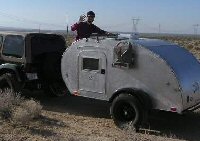eamarquardt wrote:In short: In my understanding, the 120 volt neutral neutral is not connected to the ground plane, at any point, in an RV. This prevents a reversal of hot and neutral resulting in a hot chassis. The chassis and as much of the metal of the RV as practical should be connected to the ground connection point of the distribution panel and then, via the cable connecting the RV to the campground power supply, to the campground electrical ground.
Yup, that's is the way to do it. The green wire grounds everything. The neutral (white wire) is kept completely separate from all other grounds, just like the hot (black wire). If the black wire happens to touch metal somewhere, the fault currents are conducted to ground via the green wire, the circuit breaker trips and the fault it interrupted. No ground wire means *you* could potentially be the path to ground if a black wire touches metal.
eamarquardt wrote:I see no reason to ground the negative side of the battery to the chassis as it is better to use dedicated wire for the return of the current from the positive post to the negative post (although the electron flow is from negative to positive) for 12 volt circuits. I see it as a plus to keep the 120 volt a/c and 12 volt dc systems completely isolated from one another. I have seen problems when the ground lead of an inverter is electrically connected to the negative terminal on a battery. It seems tough to keep all the terminology straight.
I don't use the frame as a conductor either but I still bond the battery to the frame for the same reason as the AC side is bonded; I want a good current return path for faults to return to the battery and open the fuse. Granted, the potential for electrocution is much lower but the principle is the same. I also want my battery ground at the same potential as everything else that could potentially conduct electricity (so it doesn't conduct electricity through me). You have to have a voltage difference to conduct electricity and grounding everything together eliminates the voltage difference.
Now, is it a huge problem if you don't ground everything to code? Probably not as I've never seen a post from someone about being shocked badly. Just don't bond the neutral wire to ground. The fact that most of us are working with wood probably explains a lot. I have to bond everything because I should know better.

There's something wrong with an inverter that doesn't work when the case is grounded. Check out some installation manuals for inverters and you'll find that they all require it.
Bruce







